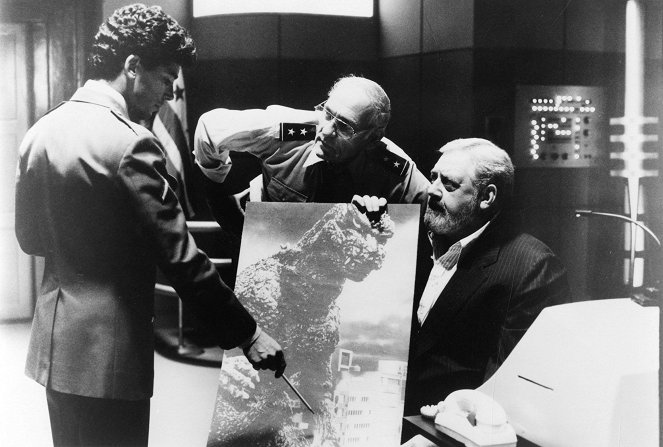Composer:
Reijiro KorokuCast:
Taketoshi Naitō, 佐藤慶, Nobuo Kaneko, Raymond Burr, Shinpei Hayashiya, Kenpachiro Satsuma, 武田鉄矢, Warren J. Kemmerling, Keiju Kobayashi, 宅麻伸, Eitarô Ozawa (more)Videos (1)
Reviews (3)
But what must be acknowledged about the movie "Gojira" from 1984 is the fact that it plays with special effects much better than its predecessors, who essentially only used a person in a costume. Here, the effort to somewhat continue the narrative of the first film is evident. The special effects are good, but the story is quite ordinary, with the most pleasure probably coming from returning to the classic concept, where Gojira is a monster that is also likely mutated. Any mythological element is lost from the plot, but it is closer to the concept accepted by Americans, which will probably be somewhat familiar to us as well.
()
This film (the 16th) was made to celebrate the 30th anniversary (and nine years since the previous film) and received due respect. From budget to concept. They ignored all the sequels and revisited the 1954 original. No kaiju battles, no "buddy Gojira as protector of mankind". All serious Gojira films have always been, are, and hopefully will be about humanity's mistakes, their correction, and some sort of transcendence (in the original the aftermath and fear of nuclear bombs, in Shin Godzilla the bureaucratic and dysfunctional governmental procedures and the mishandling of Fukushima, etc.). This one is no different. It works with the atmosphere of the Cold War, nuclear armament, and Japan in the grip of the conflicting interests of the Soviet Union and the Americans. Yes, despite the seriousness and the budget, the monster scenes are still about a guy in a rubber suit stomping on a model of a city. But how nice and detailed. As much as the catastrophe scenes take longer than they should, there's not a shortage of them, and they're impressive. Mainly because there's a respect coming from Gojiraka. The problem, however, is the pacing. The running time is too swollen giving too much space to the fates of uninteresting characters. The scientist sensei and the prime minister are alright, the scientist padawan okay, but the space given to his sister and the journalist is too much. Instead of giving human scale and heart to all this monster destruction, it just dilutes the pace.
()
17) GODZILLA 1985/THE RETURN OF GODZILLA – HEISEI SERIES 1984-1995. Perhaps the most ambitious Godzilla film. It was supposed to re-open the American market and revive the former glory of the 50s, which didn't quite happen. There is an evident attempt at realism in the visual effects, along the lines of Star Wars, but the result is again a costumed actor walking among disproportionate models of buildings and demolishing whatever he comes across. Personally, I'm glad, because this failure makes the Godzilla franchise what it really is: a quirky cult classic for B-movie connoisseurs. The infantilism is gone, serious strings are played, there is even a bit of politics when the Russians and the Americans, who themselves are afraid of being attacked by Godzilla, try to persuado the Japanese Prime Minister to let them destroy Godzilla with atomic bombs, with pathos dripping on all sides. The Prime Minister rejects the offer and tries to destroy Godzilla with the Super X weapon, which fires some sort of special cadmium ammunition. In the end, Godzilla is imprisoned in the crater of a volcano, and more sequels can come.
()



Ads